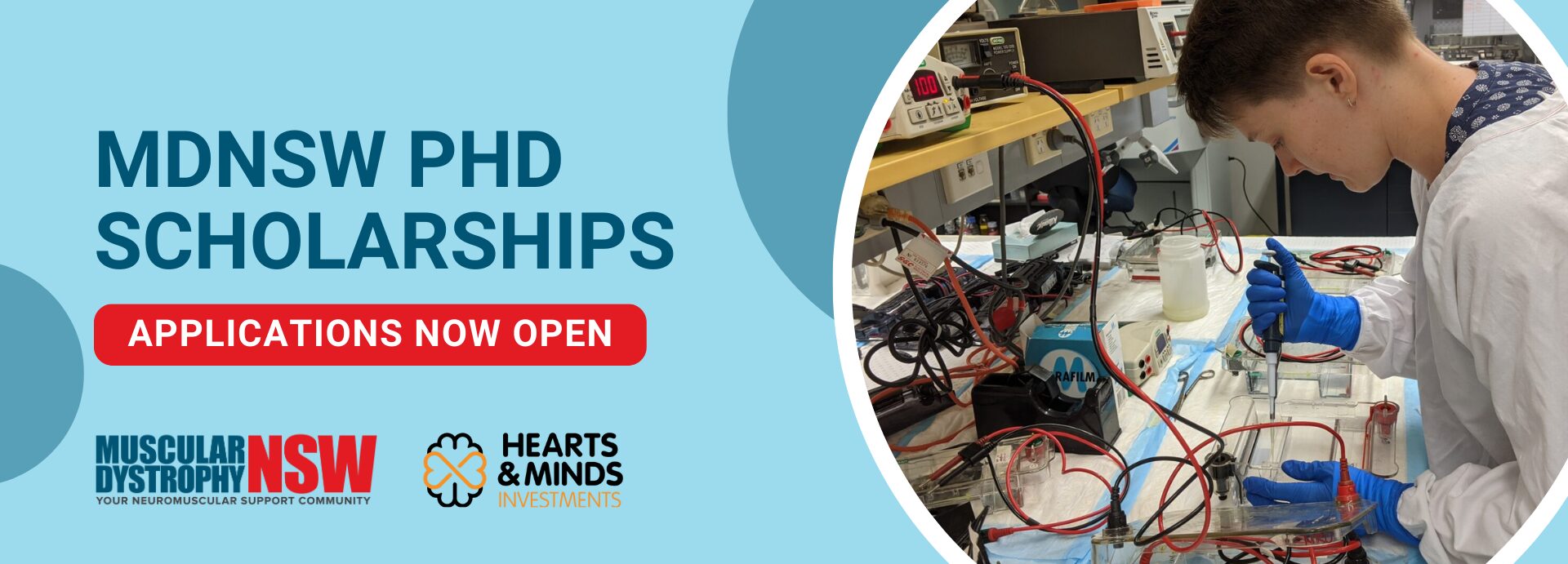Muscular Dystrophy NSW Postgraduate Scholarship for Medical Research into Neuromuscular Disorders – available now!
- Contribute to the development of new treatments for neuromuscular disorders.
- See the impact of your research first-hand within the neuromuscular community.
- Fast-track your professional development and build your network within medical research.
In partnership with Hearts and Mind Investments Group, Muscular Dystrophy NSW is offering two full-time postgraduate scholarship opportunities for suitably qualified candidates in a relevant discipline to undertake research studies in neuromuscular disorders, leading to a PhD.
“I really enjoyed the opportunity to present my work at the Neuromuscular Information and Research Days and meet members of the community my diagnostic research was aimed to help. I am very grateful for Muscular Dystrophy NSW’s support throughout my PhD candidature.”
– Samantha Bryen, 2018 MDNSW PhD Scholarship recipient
ABOUT THE PROGRAM:
The primary objective of the PhD scholarship program is to support research that will increase our understanding of neuromuscular conditions and help to identify new diagnosis and treatment options. The program aims to provide financial support to PhD students, giving them the opportunity to work on cutting-edge research projects and develop their skills as researchers. The program also aims to facilitate collaboration between researchers, institutions, and organisations to ensure that the research findings are disseminated widely and have a significant impact on the field. Ultimately, the program aims to contribute to the development of new treatments and improve the lives of individuals affected by neuromuscular conditions.
AMOUNT AWARDED:
The scholarship is valued at $39,000 per annum (tax exempt, if conditions are met) and may be renewed for up to three years, subject to satisfactory progress.
HOW TO APPLY:
Simply fill out this application form and follow the prompts. You will need to provide all the relevant documentation detailed in the form including an updated CV, your academic transcript, evidence of your citizenship or permanent residency status and two referee reports.
DOWNLOAD THE APPLICATION FORM HERE
DOWNLOAD REFERENCE FORM 1 HEREDOWNLOAD REFERENCE FORM 2 HERE
KEY DATES:
- Monday, 29 April 2024: Applications open.
- Friday, 28 June 2024: Applications close by 5pm COB.
- July 2024: Proposed peer review.
- August 2024: Announcement of recipient.
WHO’S ELIGIBLE:
- Candidates should have an undergraduate degree in a discipline relevant to the proposed title of the PhD degree which they wish to undertake.
- Candidate must meet citizenship or visa requirements and reside in Australia throughout the funding period.
- Candidate must meet all the requirements of the Administering Institution to enrol in a PhD degree.
- The Administering Institution must be in NSW.
- Candidate must not hold any other scholarship or substantial government or non-government grant which has been obtained for the purposes of supporting the PhD degree.
WHAT HAPPENS NEXT?
- All scholarship applicants are graded and assessed by an independent PhD Review Panel, coordinated by A/Prof. Alastair Corbett.
- Alastair Corbett is an Honorary Visiting Medical Officer in the Neurology Department at Concord Hospital and Clinical Associate Professor University of Sydney. In 1986 he was appointed as head of the Neurology Department, Concord Hospital and continued in that role until 2016. He established a Neuromuscular clinic including Clinical Geneticist, Rehabilitation team and close liaison with Cardiology and Respiratory Medicine and continues clinical research in inherited and acquired Neuromuscular disorders.
WANT TO KNOW MORE?
If you have any questions or would like further support, please contact us at info@mdnsw.org.au or phone (02) 9888 5711 for more information.
“I wouldn’t be (where I am today) if it weren’t for the MDNSW scholarship. It was a leap of faith and I’m hugely grateful for the vision of the Board and teams. The MDNSW community has become a huge part of my life for so many years and I’m excited to see a new era of genetic therapy making a difference in people’s lives,”
– Kristi Jones, 1996 MDNSW PhD Scholarship recipient
ABOUT NEUROMUSCULAR CONDITIONS:
Neuromuscular conditions can affect people at different stages of their lives and onset of symptoms can occur from birth to adulthood. The severity, onset, and progression of muscular dystrophy can vary widely depending on the type of condition, and often results in progressive deterioration of muscle strength and function, loss of mobility, pain, fatigue and more, resulting in profound disability. There are currently 40,000 people living with a neuromuscular condition in Australia, and approximately 13,000 of whom live in NSW.
Understanding the underlying mechanisms of these conditions is critical to developing new treatments that can improve the lives of affected individuals. Neuromuscular conditions are also a significant financial obligation on healthcare systems, with high healthcare costs associated with managing symptoms and providing ongoing care. The MDNSW PhD scholarship program aims to address this knowledge gap by funding research projects that will investigate the causes of neuromuscular conditions or explore potential treatment options.

